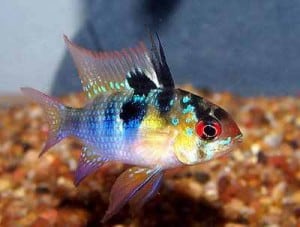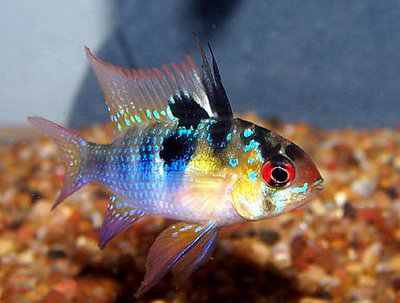
Common Name: Electric Blue Ram, Ram, German Ram, Blue Ram
Scientific Name: Mikrogeophagus Ramirezi, Apistograma Ramirezi
Average Adult Fish Size: 7 cm / 2.7 inches
Place of Origin: Orinoco River basin of Venezuela and Colombia.
Typical Tank Setup: Well planted with rock work and/or bogwood / driftwood.
Recommended Minimum Aquarium Capacity: A well established 20 gallon / 80 litre
Compatibility: They are a peaceful community type fish and should be kept with other peaceful fish of similar or smaller size.
Temperature: 25.5 – 29.5 Deg C / 78 – 85 Deg F
Water Chemistry: pH 5.0 – 7.0
Feeding: Will generally accept flakes, micro- pellets, frozen and live foods that are suitable for their size.
Sexing: The female fish is smaller than the male and has more pink pigmentation on her ventral region. If you look at the anterior region of the dorsal fin, you can see that her fin rays are less developed. It is also common for females to have a plumper body shape and more rounded edging of the tailfin. The back of the dorsal and anal fins have a more pointy edge in the male ram, and the tail fin is also more sharply edged. The male ram can be recognized on his V-shaped tail fin and the elongated second ray that is present in the dorsal fin.
Breeding: The German blue ram forms monogamous pairs and both parents engage in taking care of the fry. If you want a breeding pair to form, purchase a group of juvenile fish and let them grow up together. They will then form their own pairs as they reach sexually maturity. Rams can reach sexual maturity at a fairly young age; sometimes the fish is no older than 4-6 months.
If you want to coax your rams into breeding, provide them with soft water and increase the water temperature a bit, up to 28 Deg C (82 Deg F). The recommended pH range is 5.5 – 6.5. Use a timer for the aquarium lights, because erratic day and night patterns can confuse them and interfere with normal breeding behavior. Include flat rocks in the aquarium set up. Some pairs prefer to dig small pits in the gravel and use as breeding sites instead of, or in combination with rocks.
Don’t forget that Rams will become more aggressive than normal during the breeding period, and offer plenty of hiding spots. When its time for breeding, the red patch on the belly of the female will grow bigger and become much brighter than normally. A flat rock will be cleaned or a pit will be dug out by either of the pair.
During spawning, the female will place small adhesive eggs on the flat stones or in the small pits. The eggs are 0.9-1.5 mm in length (0.035-0.059 inches). A typical batch will consist of 150-300 eggs, but some batches contain no more than 20 eggs while others contain over 500 eggs.
Both the male and the female fish should be allowed to stay with the offspring because this species practice biparental brood care and the parents work together to care for the eggs and guard the territory. A parent will fan fresh water over the eggs to prevent attacks from fungi and bacteria. The parents will also eat unfertile eggs to prevent them from turning into breeding grounds for pathogens.
The eggs will normally hatch within 40 hours if the water is kept in the upper part of the recommended temperature range. It will then take roughly 5 days before the offspring becomes free swimming. The free swimming fry will be kept in a dense school and be cared for by the parents. They will be escorted by their mother or father during foraging.
Don’t lose heart if the first few spawnings are unsuccessful. A lot of things can go wrong and it is common for Rams to spawn a few times before they get everything right. They might for instance eat a few batches before they become good parents. Once they have started breeding, you can however expect a new batch once a month or so. Young pairs are known to fight quite a lot and the aquarium must contain plenty of hiding spots to avoid stress and injury.
If your couple continues to eat their offspring even after several spawnings try to figure out what stresses your fish and do your best to make the aquarium more relaxing for them.
Fry will readily accept baby brine shrimp and micro-worms.
Additional Information: Rams are an extremely beautiful dwarf cichlid.


Related Posts
Croaking Gourami – Trichopsis vittatus
Benthochromis Tricoti
Large-eyed Mouthbrooder – Callochromis Macrops